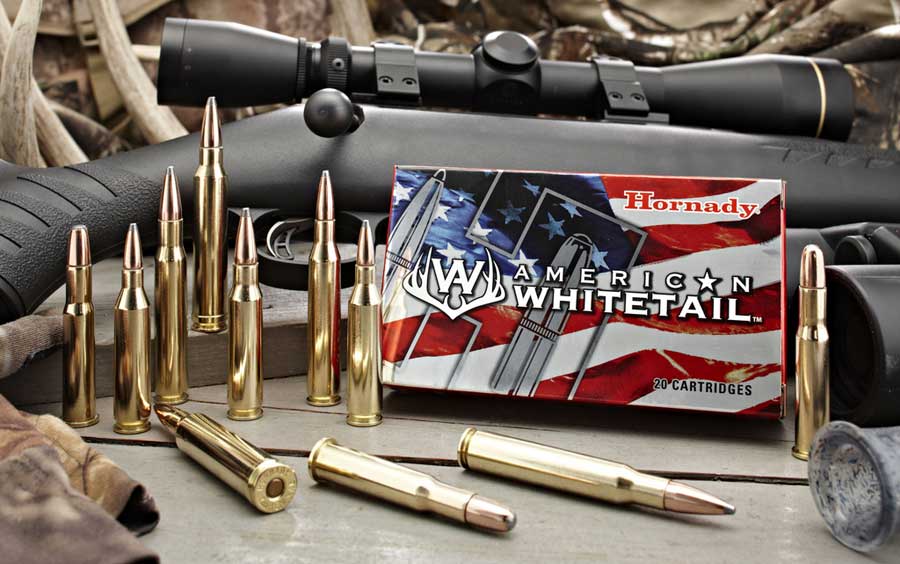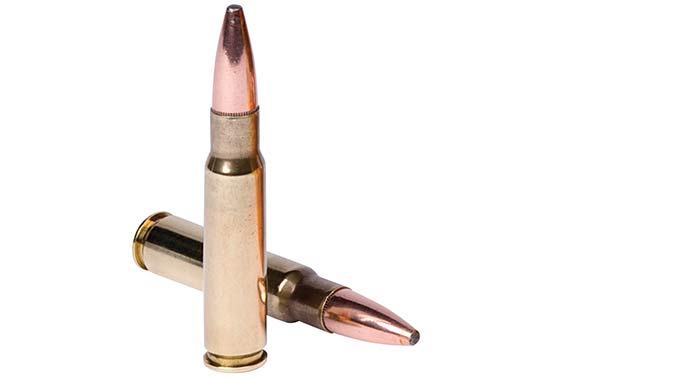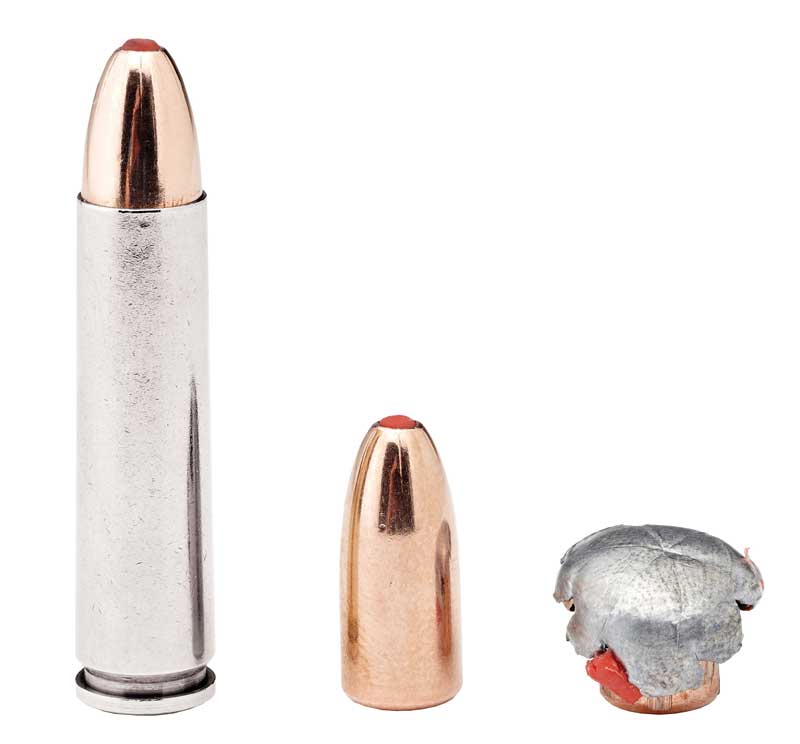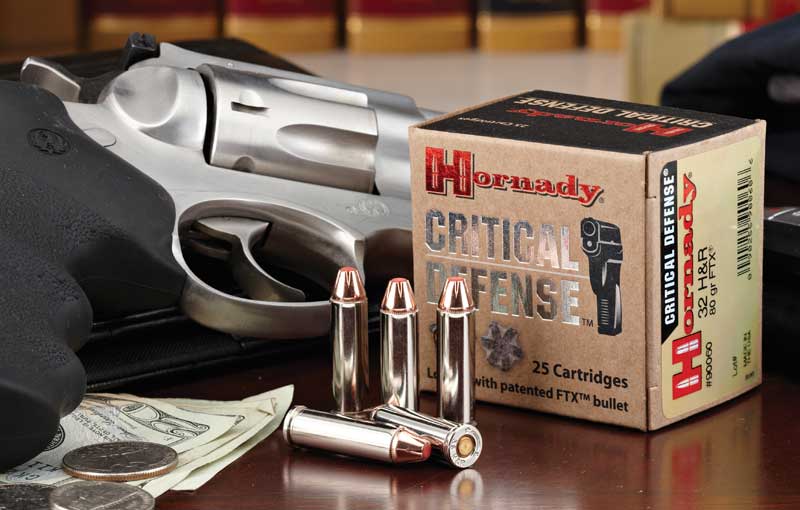Without ammunition, a firearm isn’t much use. Ammo is a critical component of any firearms activity: recreation, competition and self-defense. Picking the right load for your gun and activity is extremely important.
I will explain some common terms and ideas around ammunition. Also, if you are looking for specific information on a particular caliber or a detailed ammunition review, please check out the list of articles below.
Ammunition Reviews
- 9×18 Makarov Self Defense Ammo Guide – Makarov pistols flooded into the United States after the wall fell in Berlin, and the Russian people rejected the continuation of the USSR. These handguns were solid performers that offered excellent pricing. Unfortunately, there has never been the support from the domestic ammo companies that I wished would appear. The number of self-defense loads for this caliber is relatively small, but there are some good choices available.
- Hornady Critical Defense in .357 Magnum – I had a chance to take the .357 Magnum version of the Critical Defense ammunition for a spin. Shooting this out of small framed revolvers – the LCR and the 640 – was a literal blast. Sure recoil was big in this ammo review, but so was the fireball. Compared to a .38 Special, however, this stuff was a significant improvement in velocity and energy.
- Hornady Critical Duty – Geared at the law enforcement market, Hornady took the information they gained from the Critical Defense handgun line and amped it up. These rounds are designed to penetrate deeper and defeat intermediate barriers. Essentially, the company built this ammo to meet or exceed the standard FBI testing protocol for handgun ammunition. The result? Great reliability, expansion and penetration. Take a look at my review of this ammo.
- Liberty Ammunition Civil Defense – Light and fast. That is what Liberty Ammunition’s Civil Defense line boils down to. The company developed light-for-caliber solid copper hollow point bullets and plated them with nickel for increased lubricity. In my review, I discovered real-world 2,000 fps velocities are common with duty-sized handguns. Pistol caliber carbines drive the velocities even higher.
- New Ammunition for 2016 – This is a comprehensive run-down of all of the new loads and calibers introduced during 2016. Most of these new loads were shown or announced at the SHOT Show, but many were rolled out during the year.
- SIG SAUER Elite Performance 9mm Ammo Review – SIG SAUER jumped into the ammunition market just a few short years ago. Now that it has been out in the wild, I decided to take a look at it. Does it perform as well as other modern defensive ammunition?
- Winchester Train & Defend Ammo in .380 – I got a few boxes of the Train and of the Defend and headed to the range with five different guns. How did the ammo run? Very well, actually. But I do have a concern about the Defend load. Please read this ammunition review before buying anything.
- Winchester USA Forged – Getting good with a handgun is like getting to Carnegie Hall: both require practice, practice, practice. Winchester recognized that modern ammunition has gotten more and more expensive over the years, resulting in a reduction of shooting time for a lot of people. To address the need for less expensive ammo, the company introduced the USA Forged line. These 9mm rounds use steel cases to help bring the price down. They are made in the USA. But, are they reliable? Click the link and read my review.
Ammunition Glossary

For those that are new to the shooting hobby, there can be a great deal of confusion with the terminology surrounding ammunition.
I am to clear things up a little with this short list of terms and acronyms used to describe ammo. If you have any additional questions – please shoot me an e-mail. I’d love to be able to help you out, and your questions may inspire additions to this page.
ammo – This is a term that is short for ammunition.
ammunition – One piece of ammunition is a completely loaded round that is ready to be loaded into a gun and fired. Ammunition is self-contained, meaning that the components are not loose. Ammunition is stable and can be handled normally without fear of it “going off.”
armor piercing ammunition – This is ammunition that is able to penetrate steel plating. However, this is an often misused term that has bred a great deal of confusion for many people.
In the law enforcement context, all ammunition can be armor piercing since body armor worn by police officers is not bullet proof. Rather, it is bullet resistant. Different classes of body armor are rated to defeat different threats at a 50% rate.
Most police-worn body armor will stop most handgun projectiles. However, none of it will stop centerfire rifle projectiles. Some heavy, hard armor panels will stop some centerfire rifle bullets.
Keep in mind that you are trying to stop a small bullet traveling faster than the speed of sound from piercing a small, thin panel. The fact that body armor works at all is a scientific wonder.
While armor piercing ammunition has an actual legal definition, it is largely irrelevant as the term has been co-opted by anti-gun groups and politicians to deceive the general public.
Armor piercing ammo is sometimes referred to as “AP”.
ballistics – Ballistics is the scientific study of projectiles. In a shooting context, this may refer to how the bullet behaves inside the barrel, in the air on the way to the target or when it hits the target. These are referred to as interior ballistics, exterior ballistics and terminal ballistics respectively.
In the context of criminal investigations, “ballistics” is a slang term referring to an aspect of crime laboratory analysis that tries to identify the kind of bullet uses and to match it to the gun that it was fired from.
BB – A BB is a round projectile used in airguns and shotgun ammunition. For airguns, a BB is typically made of copper or other hard metal and is 0.175″ in diameter. In shotgun ammunition, the BB may be made of lead, copper, steel or other metals. It is about 0.180″ in diameter and is packed into the case in an amount proportional the gauge of the shotgun. Regarding shotgun ammunition, see also “shot.”
Berdan primer – This is one form of modern centerfire primer in common use today with the other being a Boxer type. Ironically, it was developed by a US citizen, but is almost never used in commercial ammunition manufacture in this country. This primer type relies on an anvil on the cartridge case for reliable ignition. Cases using Berdan primers are reloadable, but through a process that is more difficult that with Boxer primed cases.
big bore – This is a relative term that generally means any caliber with a bullet diameter greater than 0.30″.
birdshot – Birdshot is a form of shot fired from shotguns. Birdshot are small pellets that are no larger that 0.10″ in diameter, and it is typically used for hunting birds or breaking clay “pigeons” in recreation or competition. Sizing runs from #4 (the largest) to #12, with the size of individual pellets getting smaller as the number gets larger.
bore – The bore is the size of the “hole” in the barrel. Bore size must be carefully matched to bullet size to ensure good accuracy and velocity. Bores can be smooth (as with a shotgun) or cut with spiral grooves. The grooves impart a spin to the bullet as it travels down the barrel, significantly improving accuracy. The spiral grooves are often referred to as “rifling.”

bottleneck case – A bottleneck case is one in which the walls sharply narrows such that the mouth of the case has a smaller diameter than the base. The image above shows a pair of cartridges made with a bottleneck case.
Boxer primer – Boxer type primers were developed by Colonel Edward Boxer of England and are the dominant small arms primer in the United States. These primers incorporate the anvil into the primer, as compared to the Berdan style (above) that relied on an anvil incorporated into the cartridge case. Although more difficult to make, the Boxer primer makes ammunition easier to commercially manufacture and reload.
buckshot – Like birdshot, buckshot is made of round metal pellets – frequently lead – that are packed into shotgun ammunition. Buckshot is significantly larger than birdshot, ranging from 0.20″ to 0.36″ in diameter. Also like birdshot, buckshot uses a numbering system that indicates the size of the shot.
Sizing runs from 000 (or “triple aught”) to #4. Since birdshot also has a size #4, most people refer to #4 buckshot as “#4 buck.” One of the most popular sizes of buckshot is 00 or “double aught.”

bullet – A bullet is a shaped projectile that is fired from a firearm. It is one component of a single piece of ammunition. There are many different sizes and types of bullets. The bullet’s diameter is referred to as the caliber.
In the above image, the complete cartridge is on the left with an unfired bullet in the middle. A fired bullet that expanded is shown on the right side of the image.
caliber – Caliber has two meanings. The first is the actual diameter of the bullet. The second refers to the specific cartridge name.
Frequently, the diameter of the bullet is not the same as the cartridge name. For example, the .38 Special cartridge has a bullet diameter of 0.357″.
Naming conventions for calibers follow some generalities, but they are not hard and fast rules.
Typically, cartridges that originate in Europe have a metric designation, while those that were developed in the United States often use imperial measurements. However, this is not absolute.
Also, some cartridges have multiple names. Other times very different cartridges have similar names, but are in no way interchangeable. As an example, the common 9mm cartridge is properly called the 9x19mm or 9mm Parabellum. The military version of the cartridge, which is useable in most 9x19mm handguns, is called the 9mm NATO. However, this cartridge is definitely not interchangeable with the 9mm Largo or 9mm Makarov.
There are thousands of cartridge names, so if you are not sure if a cartridge should be fired in a gun, check with a trusted source of information.
cartridge – A cartridge is a single, complete piece of ammunition. One cartridge may be referred to as a single round of ammunition. A centerfire cartridge is made up of a case, a primer, powder and a bullet.
case – A case is the metal body of a single round of ammunition. The case contains power inside of it when it is part of a cartridge. The bottom of a case holds the primer (for centerfire cartridges) or is coated with a priming compound (for rimfire cartridges.) The top of the case is open, which is referred to as the mouth of the case. The bullet, or projectile, is seated into the mouth of the case.
Cartridge cases can be made from a variety of materials. The most popular is brass, but steel and aluminum are also used. Due to the popularity of using brass as a case material, many people refer to cases as “brass.”
After a bullet is fired from the gun, the case stays behind. In a revolver, the case remains in the gun’s cylinder. In a semi-automatic gun, the case is ejected from the gun and lands nearby.
Cases can be re-used through a process called reloading. Aluminum is almost never reloaded, while brass is commonly reloaded. Reloading steel cases can be done, but it is often only tried with hard to find cartridges.
centerfire – Centerfire refers to a class of ammunition that uses a primer that is seated in the middle of the case bottom. The majority of modern handgun and rifle calibers are considered centerfire rounds. The other modern ammunition system is called rimfire.
Dum-Dum – This is an archaic term that will not die. In the 1800’s, the United Kingdom fielded a relatively ineffective military round that was developed in the Dum-Dum arsenal in India. This rifle round used a jacketed bullet with an exposed tip in an effort to improve terminal effectiveness.
Under the 1899 Hague Convention, the signatories agreed not to use such ammunition in military applications. For a better understanding of why the Hague Convention took place, and why it should be abandoned in favor of modern treaties, I humbly recommend listening to Dan Carlin’s Hardcore History podcast, Blueprint for Armageddon Vol. 1 on World War I.
Dum-Dum bullets were not hollow point bullets, and their effectiveness has been oddly blown out of proportion by ignorant movie producers.
FMJ – This is an acronym for “full metal jacket.”
full metal jacket – Full metal jacket is a bullet type that uses two kinds of metal. In this type of bullet, the core of the projectile is typically made of lead, while a thin copper layer covers the lead. The layer is referred to as the bullet’s jacket. Since the none of the lead is exposed to the air (at least until fired,) the bullet is considered to have a full jacket around it.
Full metal jacket loads are most frequently used for target practice from semi-automatic pistols and rifles. Since there is no exposed lead and they often have a round nose, they can be slightly more reliable at feeding in some kinds of firearms.
FMJ rounds do not expand and tend to over-penetrate in defensive shootings. Few people recommend them for self-defense, and I know of no law enforcement agency that would allow their use on duty.
gauge – Gauge is a way of measuring the bore of a shotgun barrel. Today, the most common gauges are 12, 20 and 28. Other gauges, such as 10 and 16, also exist.
The gauge number corresponds to a bore diameter, and the lower the gauge number, the larger the bore measurement. For example, a 12 gauge shotgun has a bore diameter of .730″ while a 20 gauge has a bore of only .615″.
One shotgun uses a caliber instead of a gauge: the .410. The number .410 is the actual bore diameter, not a gauge. In some places outside the United States, the .410 is referred to as being 67 gauge.
hollow point – This is another style of bullet. As the name suggests, these projectiles have a hole in the nose of the bullet.
Hollow point bullets are designed to expand when striking a target. This expansion is intended to (1) do more damage to the target and (2) reduce the chances of over-penetration.
Bullets that do not expand when striking a target tend to make a small hole and go straight through. In a self-defense shooting, blood loss is often the quickest way to stop an attacker from harming you. The more bleeding the bullet causes, the more rapidly the aggressor’s attack can be stopped. An expanding bullet is more likely to cause more bleeding, and therefore stop the attack quicker.
Every law enforcement agency I am aware of in the United States requires the use of hollow point ammunition. The vast majority of self-defense instructors recommend their use as well. Additionally, hunters prefer the use of expanding ammunition in most cases.
hull – A hull is the case used for shotgun cartridges. The hull can be made of metal, paper or plastic. Most modern hulls are made of plastic with a metal base. Plastic hulls became very popular starting in the 1960’s. Previously, paper hulls were extensively used, but were frequently ruined due to excessive humidity, rain and other environmental conditions.
jacket – A jacket is a metal layer that covers the core of a bullet.
jacketed hollow point – A jacketed hollow point is a bullet type that adds a metal layer on top of the hollow point core. This can be done to increase reliability of the ammunition in semi-automatic firearms. It can also be used to affect the rate of expansion after the bullet strikes the target.
JHP – JHP is an acronym for “jacketed hollow point”.
Magnum – Although made famous by Dirty Harry, the term “Magnum” doesn’t have any quantitative meaning. Rather it is a general term that indicates a particular load or cartridge is more powerful. More powerful than what is sometimes the real question.
Some cartridge names have the word Magnum in them. Some of these include the .357 Magnum, .44 Magnum and .300 Winchester Magnum.
powder – The propellant used in a round of ammunition. It is one of four parts of a common centerfire cartridge. Modern smokeless powders burn to create the force needed to propel a bullet from the gun. Smokeless powders do not explode.
A form of propellant called “black powder” is used in muzzle loading applications, and is not used in cartridges. Black powder has been in use for hundreds of years and was first used in firearms around the 13th Century.
Modern smokeless powders have been in wide use for more than 100 years. Although these powders do create some smoke, it is much, much less than black powder.
primer – The primer is one of four main components used to manufacture a centerfire cartridge. The primer sets in the bottom of the cartridge case and is struck by the firing pin of the gun. When struck, it emits a spark that ignites the powder inside the case.
projectile – A projectile is what a gun fires from its barrel. Typically, the projectile is a bullet. However, shotguns fire multiple projectiles at the same time called shot. Other projectiles available for firearms, but are far less common.
reloading – In the context of ammunition, reloading is the act of taking a case that has been fired and making it a completed piece of ammunition again.
The reloading process involves:
- cleaning the case and inspecting it for damage
- shaping the case into the proper size
- removing the old primer and seating a new one
- adding the proper amount of smokeless powder
- seating a new bullet in place
When done correctly, reloading can be a fun hobby and allow you to experiment with different aspects of ammunition manufacturing to improve accuracy. However, it requires attention to detail to prevent dangerous accidents such as making a round with too much powder that “blows up” your gun.
rimfire – Rimfire cartridges are rounds that replace the stand along primer with a paste-like primer material that is applied to the interior, bottom of a case. When the gun’s firing pin strikes the edge, or rim, of the cartridge, it ignites the primer compound and initiates the firing of the bullet from the gun.
Rimfire cartridges are a small part of the overall market. However, the .22 LR cartridge, a rimfire round, is one of the most popular cartridges in the world due to it being very inexpensive, yet accurate enough for sport shooting, competitions and small game hunting.
round – A single piece of ammunition that is fully complete and ready to fire if inserted into a firearm.
sabot – A sabot is a device that is used in conjunction with a projectile that is smaller than the bore of the barrel. As the bullet is smaller than the bore, the sabot keeps the projectile centered in the bore and imparts a spin to the projectile that would normally be gained when the bullet engaged with the rifling in the barrel.
Sabots are relatively uncommon in use with small arms ammunition, but are sometimes used with shotgun slugs and other centerfire rounds.
With a sabot, a manufacturer can increase velocity – and in some cases accuracy – by using a smaller, lighter bullet that still gets the same powder charge that a larger, heavier projectile would have gotten.
shell – Shell is a slang term for the ammunition case. It is most frequently associated with shotguns when the term “shotshell” is frequently used to differentiate between loads that fire multiple projectiles instead of a single, large projectile that is called a slug.
shot – Shot are pellets used in shotshells. They can be made from a variety of metals including lead, copper, steel and tungsten. Shot pellets are typically round and can be had in a range of sizes.
shotshell – A cartridge loaded with multiple pellets. These are typically used in shotguns, and are sometimes called “shells.”
slug – A single, sold projectile fired from a shotgun. Compared to shot, slugs are much larger and heavier. Slugs typically offer much better penetration than shot.
Slugs come in a variety of styles including Brenneke, Foster and sabot-type. Each slug type offers benefits and drawbacks when compared to other slug styles.
small arms ammunition – This is a military term that is used to describe most handheld firearms. Generally, this includes all guns with a bore diameter smaller then 1″. The largest commercially available ammunition for American shooters is .50 caliber, or 1/2″.
straight wall case – A kind of ammunition case, the straight wall case has a mouth that is the same diameter as its base. There are no angles in the straight wall case like there are in the bottleneck case.
trajectory – A trajectory is the path of the bullet through the air when it is shot. Trajectories are mathematically predictable and allow for very accurate long range shooting.
velocity – This is the speed of the projectile expressed in feet per second, or FPS. Speeds are typically measured with a specialized tool called a chronograph.
wad – In a shotshell, a wad separates the powder from the shot. It is typically made of plastic, and can be used by ammunition designers to affect the pattern, or spread, of the shot after exiting the barrel.
